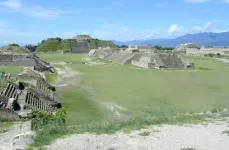(Press-News.org) Some cities only last a century or two, while others last for a thousand years or more. Often, there aren’t clear records left behind to explain why. Instead, archaeologists piece together clues from the cities’ remains to search for patterns that help account for why certain places retained their importance longer than others. In a new study published in the journal Frontiers in Ecology and Evolution, researchers examined 24 ancient cities in what’s now Mexico and found that the cities that lasted the longest showed indications of collective forms of governance, infrastructural investments, and cooperation between households.
“For years, my colleagues and I have investigated why and how certain cities maintain their importance or collapse,” says Gary Feinman, the study’s lead author and MacArthur Curator of Anthropology at the Field Museum in Chicago.
In previous studies, Feinman and his colleagues cast a wide net in terms of the cities they looked at, ranging across Mesoamerica over thousands of years. They found a broad pattern of societies with good governance that fostered the well-being of their people lasting longer than ones with autocratic leaders and big disparities in wealth. This new study tightens the focus on cities from similar places and times: all 24 of the cities analyzed were in the western half of Mesoamerica and were founded between 1000 and 300 BCE.
To a non-archaeologist, looking at ancient ruins and trying to extrapolate what its government was like might seem like an impossible task. But remnants of the cities’ buildings, ground plans, plazas, and monuments contain clues.
“We looked at public architecture, we looked at the nature of the economy and what sustained the cities. We looked at the signs of rulership, whether they seem to be heavily personalized or not,” said Feinman. Art and architecture celebrating larger-than-life rulers point to more autocratic or despotic societies, whereas the depiction of leaders in groups, often masked, is more indicative of shared power arrangements.
Feinman and his co-authors, David Carballo of Boston University, Linda Nicholas of the Field Museum, and Stephen Kowalewski of the University of Georgia, found that among the 24 ancient cities they analyzed, the ones with more collective forms of governance tended to remain in power longer than the autocratically ruled cities, sometimes by a thousand years. However, even among places that likely had good governance, some cities outlasted others.
To get at why these similarly governed cities fared differently, the researchers examined other aspects of their makeup including infrastructure and indications of household interdependence. “We looked for evidence of path dependence, which basically means the actions or investments that people make that later end up constraining or fostering how they respond to subsequent hazards or challenges,” says Feinman.
Early efforts to construct dense, interconnected residential spaces and the construction of large, central, open plazas were two of the factors that the authors found contributed to greater sustainability and importance of the early cities.
To examine sustainability in the past, most research looks for correlations between specific climatic or environmental events and the human responses. This approach may make sense, but it is hard to know whether the timing is reliable. Such studies often emphasize a correlation between environmental crisis and collapse without also considering how other cities successfully navigated the challenges and continued as major population centers.
The authors use a different tack. Knowing residents faced hazards, including drought, earthquakes, periodic hurricanes/heavy rains, challenges from competing centers and groups, they examined the durational history of the 24 centers and what factors fostered their sustainability. The finding that governance had an important role in sustainability shows that “responses to crises and disasters are to a degree political,” says Linda Nicholas, an adjunct curator at the Field Museum and co-author of the study.
The cities that lasted the longest had a combination of infrastructural investments and collective governance. It’s a lesson still relevant today. “You cannot evaluate responses to catastrophes like earthquakes, or threats like climatic change, without considering governance,” says Feinman. “The past is an incredible resource to understand how to address contemporary issues.”
###
END
The Coalition for Trust in Health & Science today announced its formation and public launch during the 2023 American Association for the Advancement of Science (AAAS) Annual Meeting in Washington, D.C. The alliance was formed to unite leading organizations from across the entire health ecosystem to advance trust and factual science-based decision-making. The partnership aims to achieve a measurable increase in the public’s willingness – and ability – to access evidence-based information necessary to make the best personally appropriate health decisions for themselves, their ...
When asteroids suffer natural impacts in space, debris flies off from the point of impact. The tail of particles that form can help determine the physical characteristics of the asteroid. NASA’s Double Asteroid Redirection Test mission in September 2022 gave a team of scientists including Rahil Makadia, a Ph.D. student in the Department of Aerospace Engineering at the University of Illinois Urbana-Champaign, a unique opportunity—to observe the evolution of an asteroid’s ejecta as it happened for the first time.
“My work on this mission ...
BOSTON – Although investigators have made strides in detecting signs of Alzheimer’s disease using high-quality brain imaging tests collected as part of research studies, a team at Massachusetts General Hospital (MGH) recently developed an accurate method for detection that relies on routinely collected clinical brain images. The advance could lead to more accurate diagnoses.
For the study, which is published in PLOS ONE, Matthew Leming, PhD, a research fellow at MGH’s Center for Systems Biology and an investigator at the Massachusetts Alzheimer’s Disease Research Center, and his colleagues used deep learning—a type of machine learning ...
Irvine, Calif., March 2, 2023 — Carbon dioxide emissions from wildfires, which have been gradually increasing since 2000, spiked drastically to a record high in 2021, according to an international team of researchers led by Earth system scientists at the University of California, Irvine.
Nearly half a gigaton of carbon (or 1.76 billion tons of CO2) was released from burning boreal forests in North America and Eurasia in 2021, 150 percent higher than annual mean CO2 emissions between 2000 and 2020, the scientists reported in a paper in Science.
“According to our measurements, boreal fires in 2021 shattered previous ...
Distinguished Professor of Food Science and prolific author David Julian McClements has a new book out this month – Meat Less: The Next Food Revolution (Springer, 2023).
Meat Less describes McClements’ journey to vegetarianism, a shift inspired by his daughter and his ongoing research work on developing healthier and more sustainable foods.
“In writing this book I take the viewpoint that there are no easy answers and that everyone must make the decision to eat meat or not based ...
Ants are known as hard workers, tirelessly attending to their assigned tasks—foraging for food, nurturing larvae, digging tunnels, tidying the nest. But in truth, some are total layabouts. Called workerless social parasites, these rare species exist only as queens, and they die without workers to tend to them. To survive, parastic ants infiltrate a colony of closely related ants, where, as long as they keep their numbers relatively low, they and their offspring become the leisure class of the colony.
It’s long been thought that ...
Most Americans view parasitic infections as a problem of the past or one that only impacts low-income countries. However, new research from Washington University in St. Louis finds evidence that the problem is likely widespread in low-resource communities throughout southern United States where environmental conditions combined with infrastructural neglect and inadequate access to health care create the perfect breeding ground for these infections.
In a small, preliminary study published on March 2 in American Journal of Human Biology, 38% of children sampled from a rural Mississippi Delta community were found to have either ...
**Note: the release below is a special early release from the European Congress of Clinical Microbiology & Infectious Diseases (ECCMID 2023, Copenhagen, 15-18 April). Please credit the conference if you use this story**
**Note – the press release is available in Spanish and Portuguese, see links below**
Embargo – 2301H UK time Thursday 2 March
Prompt recognition of symptoms and treatment is vital for good outcomes in cases of meningitis. However, new research to be presented at this year’s European Congress of Clinical Microbiology & Infectious Diseases (ECCMID 2023, Copenhagen, 15-18 April) shows both adults ...
Former professional football players who reported experiencing concussion symptoms during their playing careers were found to perform worse on a battery of cognitive tests than non-players, according to a study led by Mass General Brigham investigators from McLean Hospital and Spaulding Rehabilitation Network. Results of the study are published March 2nd in Archives of Clinical Neuropsychology.[JR1]
Of the more than 350 former National Football League (NFL) players who were studied an average of 29 years after their playing career ended, those who reported experiencing concussion symptoms during their careers ...
A review of gene editing techniques suggests that the CRISPR/Cas (clustered regularly interspaced short palindromic repeats/Cas) method could be a possible ‘saviour’ for rice crops threatened by climate change and high food demand.
The study, published in CABI Reviews, highlights that while rice is one of the most consumed cereals worldwide and feeds about three billion people, climate-induced abiotic and biotic stresses have affected the production and quality of rice crops.
Dr Antonio Costa de Oliveira, lead author of the Federal University of Pelotas, Brazil, and a team of fellow ...







